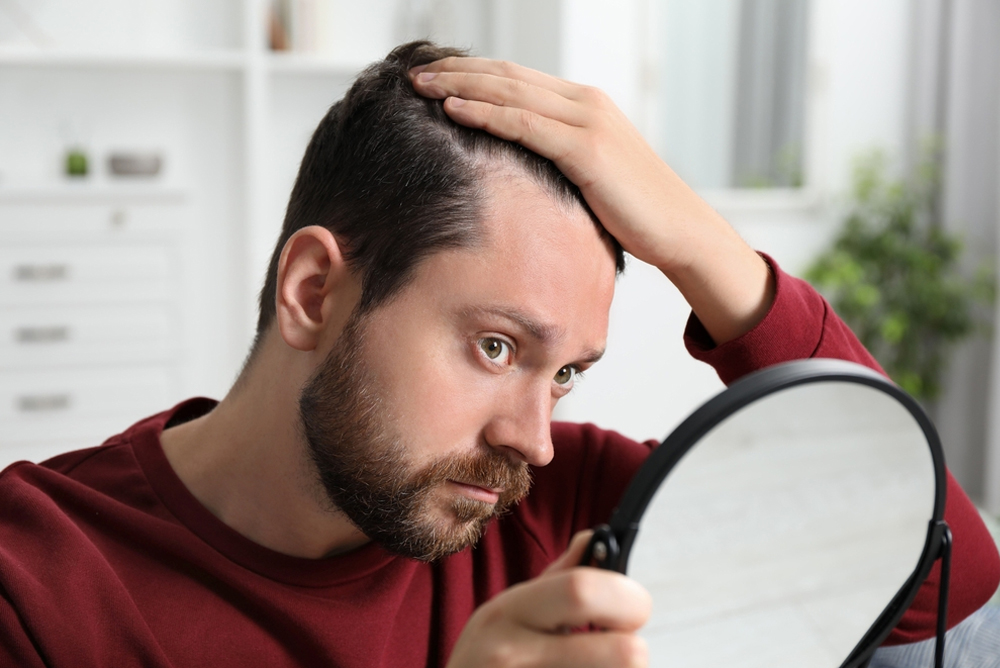
It’s normal to lose about 50–100 hairs per day as part of the natural hair cycle. However, excessive hair loss that leads to visible thinning or bald patches is a sign of concern.
There are different types of hair loss:
Androgenetic Alopecia (Male & Female Pattern Baldness) – Hereditary hair loss due to genetics and hormones.
Telogen Effluvium – Temporary hair shedding caused by stress, illness, or sudden weight loss.
Alopecia Areata – Autoimmune disorder causing patchy hair loss.
Traction Alopecia – Hair loss due to excessive pulling or tight hairstyles.
Understanding why you’re losing hair is the first step to finding a solution. Here are some common reasons:
Family history of baldness can make you more prone to hair loss.
Hormonal changes due to pregnancy, menopause, or thyroid disorders can trigger hair thinning.
Lack of iron, biotin, protein, and vitamins (D, B12, E) can weaken hair.
Crash diets and sudden weight loss can cause temporary hair loss.
Chronic stress can push hair follicles into a “resting phase,” leading to increased shedding.
Lack of sleep, smoking, and excessive alcohol consumption can weaken hair health.
Frequent use of heat styling tools, hair dyes, and chemical treatments can damage hair.
Tight ponytails, braids, or hair extensions may cause traction alopecia.
Health issues like PCOS, thyroid disorders, diabetes, and autoimmune diseases can contribute to hair loss.
Certain medications (e.g., chemotherapy, antidepressants, blood pressure drugs) may have hair loss as a side effect.
While some types of hair loss are genetic and unavoidable, many can be prevented or minimized by following these simple tips:
Eat protein-rich foods (eggs, fish, nuts, beans) for strong hair.
Increase iron and biotin intake to prevent breakage.
Stay hydrated—drink at least 2–3 liters of water daily.
Wash hair 2–3 times a week with a sulfate-free shampoo.
Avoid excessive brushing and harsh towel drying.
Use wide-tooth combs to detangle wet hair gently.
Reduce the use of straighteners, curling irons, and blow dryers.
If using heat, always apply a heat protectant spray.
Limit hair coloring and avoid bleaching frequently.
Practice yoga, meditation, or deep breathing exercises to lower stress.
Get 7–8 hours of sleep every night.
Avoid smoking and limit alcohol intake.
If you’re experiencing severe hair loss, consider proven treatment options:
Minoxidil (Rogaine) – A topical solution that stimulates hair growth.
Finasteride (Propecia) – A prescription pill for male pattern baldness.
Platelet-Rich Plasma (PRP) Therapy – Uses your own blood plasma to boost hair regrowth.
Growth Factor Concentrate (GFC) & QR678 – Non-surgical treatments that rejuvenate hair follicles.
Coconut oil + Castor oil massage for nourishment.
Onion juice – Known to improve blood circulation and regrow hair.
Aloe vera gel – Soothes the scalp and promotes growth.
If you notice sudden, excessive hair loss or bald patches, consult a dermatologist or trichologist. Early treatment can prevent further damage and improve regrowth.
Look out for these warning signs:
Losing more than 100 hairs per day consistently.
Bald patches or thinning at the crown.
Hair falling out in clumps.
Scalp itching, redness, or irritation.
Fill in your details and experience a holistic beauty experience at Lacrown.